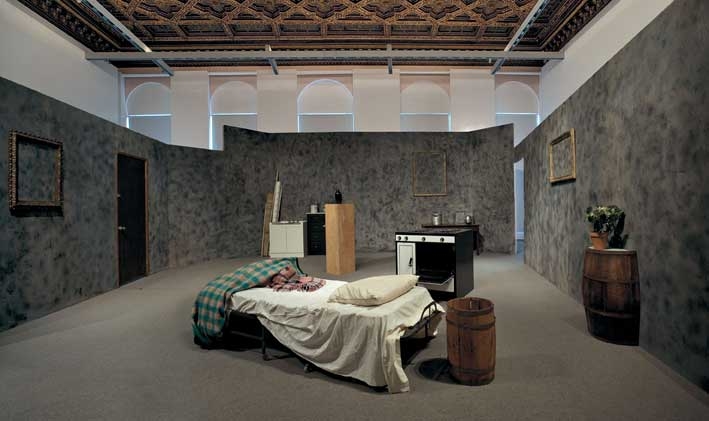While I was at this year’s Venice Biennale, it struck me that the ‘encyclopedic palaces’ of my generation had been Mike Kelley’s The Uncanny (1993) and Educational Complex (1995): the international exhibition, with its insistence on ‘repressed memory syndrome’, seemed to reflect Kelley’s influence so consistently that I found his exclusion inexplicable, and kept waiting for his work to appear. The retrospective that followed his death (as seen at the Pompidou, in Paris, in my case) had felt painfully frustrating for symmetrical reasons: as if to compensate for the lack of the artist’s presence, it packed together an oppressive number of works, making it hard to breathe. In a note on his Harems (2004), Kelley had written: ‘Every single [collection in Harems] contains absences. The uncontrollable impulse to collect and order is itself, uncanny; the strange sense of loss and wonder attendant to the gaps in collections is uncanny.’ The exhibition at Hangar Bicocca, meanwhile, goes in the opposite direction to the retrospective, not trying to mimic the artist’s entropic layouts or emphasize the collaborative nature of several of his projects.
The works are only ten in number, all solo and large-scale, and they are theatrically made to emerge as luminous islands from the cavernous dark space. What’s not there is, clearly, the majority of Kelley’s oeuvre: this was an admittedly personal choice. The show is cocurated by Andrea Lissoni and Emi Fontana, who had been close to Kelley. In 2000, Fontana invited him to show in her (now closed) gallery in Milan the first episode of the cycle Extracurricular Activity (which would become, in 2005–6, the monumental musical Day Is Done at Gagosian New York), then moved to LA after she and Kelley started a relationship. They broke up, but kept in touch, so that the selection records the same years, 2000 to 2009, like a diary.
The works are only ten in number, all solo and large-scale, and they are theatrically made to emerge as luminous islands from the cavernous dark space.
The first work is thus Extracurricular Activity Projective Reconstruction #1 (A Domestic Scene), 2000. It works well as a prologue in many respects: as a recreation of the set of the high-school play whose picture Kelley had found in a yearbook, it uses theatre as a symbol of his continual research into rituals of representation and ‘deviance’. The video restages the half-hour existentialist drama heavy-handedly played inside the same set by two actors. With a good deal of deadpan humour, the title of the exhibition comes from one of them, who says: “Eternity is a long time, isn’t it?” before sticking his head in the oven.
The sequence of works is organised by free associations, instead of chronology, to reflect the circularity of Kelley’s sense of time, where past and present obsessively collide, as well as his recursive analytical approach. Light (Time) – Space Modulator (2003), which pays tribute to Moholy-Nagy’s kinetic sculptures, is a time machine: a spiral staircase taken from the artist’s house revolves horizontally, thus making the slide projections turn around as well. Some images are found snapshots of the Latino American family who had lived in the same house, others are photos Kelley took by reinterpreting the original scenes in the same places, in an endless loop of haunting proximity. The large installation, divided in office cubicles, A Continuous Screening of Bob Clark’s Film ‘Porky’s’ (1981), the Soundtrack of Which Has Been Replaced with Morton Subotnick’s Electronic Composition ‘The Wild Bull’ (1968), and Presented in the Secret Sub-Basement of the Gymnasium Locker Room (Office Cubicles), 2002, gathers hundreds of drawings, sketches, maps and newspaper clippings used by Kelley for the Educational Complex, thus showing full evidence of his fixation on indexing.
John Glenn Memorial Detroit River Reclamation Project (Including the Local Culture Pictorial Guide, 1968–1972, Wayne/Westland Eagle) 2001, too, looks like a self-ironical monument to Kelley’s compulsion to mine his own past: commissioned for the 300th anniversary of the founding of Detroit, it consists of a large statue of America’s first astronaut (and illustrious local hero), covered in debris and multicoloured fragments of glass, ceramic, metal and trash collected by the artist in Detroit’s riverbed. It’s the most autobiographical work on show here: Kelley’s high school was dedicated to John Glenn, and it’s with an obvious pleasure that the artist turned him into a ridiculous harlequin, his bottom smeared in dubious brown stuff. The last work, presented in the vast cubicle at the back of the Hangar, is a surprisingly lyrical ode to art history and poetry: created for the Louvre in 2006, Profondeurs Vertes (Green Depths) is a multimedia installation hypnotically focusing on two paintings, seen by the artist as a child at the Detroit Institute of Arts, which had deeply fascinated him: Watson and the Shark (1777)
by John Singleton Copley and Recitation (1891) by Thomas Wilmer Dewing. The whispered soundtrack is made up of readings from the second canto of Les Chants de Maldoror by the Comte de Lautréamont (aka Isidore-Lucien Ducasse) and excerpts from female writers and poets of nineteenth-century America.
Kelley notoriously hated the ‘bad boy’/‘slacker’/‘dysfunctional’ label perennially attached to his work. When, back in 2000, I interviewed him in Milan, I was foolishly surprised to hear him say that “art has to be academia, to have a critical function, look at things and analyse them, instead of being just good fun or stupid consumption. I am not a populist”. I think I understand a bit better, now.
This review originally appeared in the September 2013 issue.
